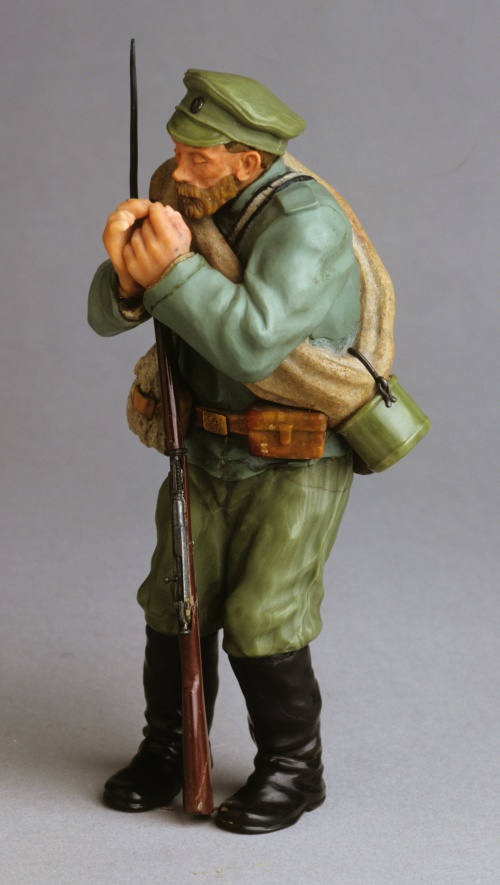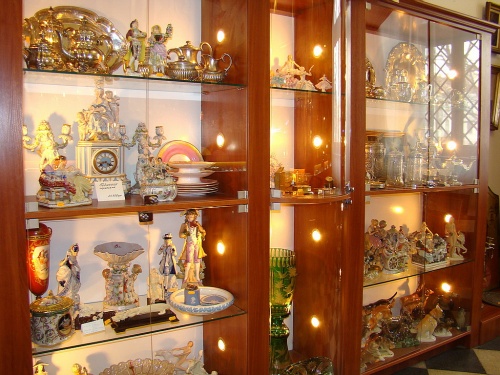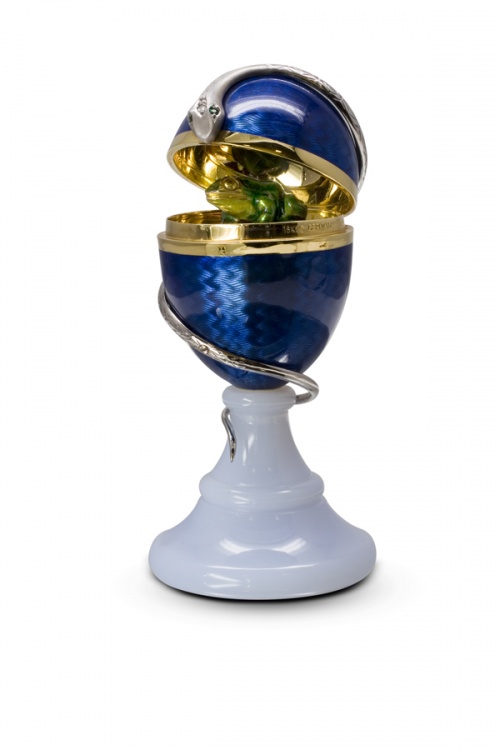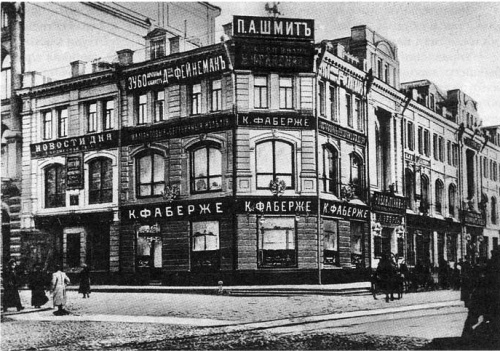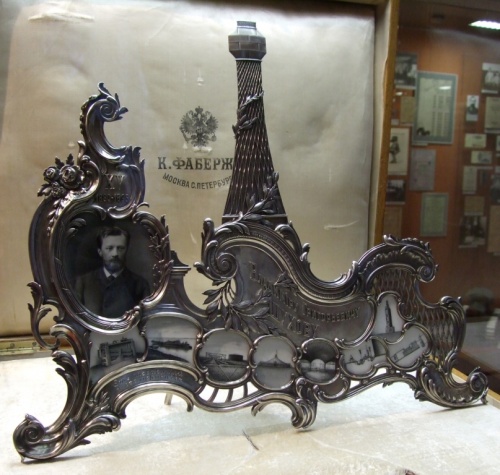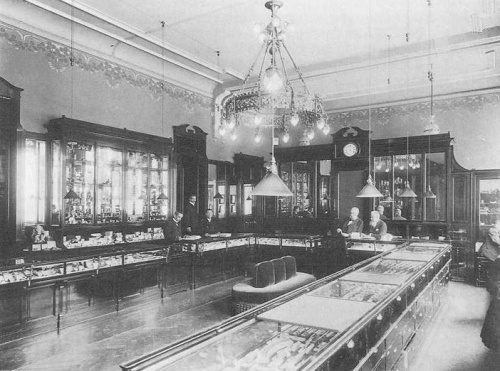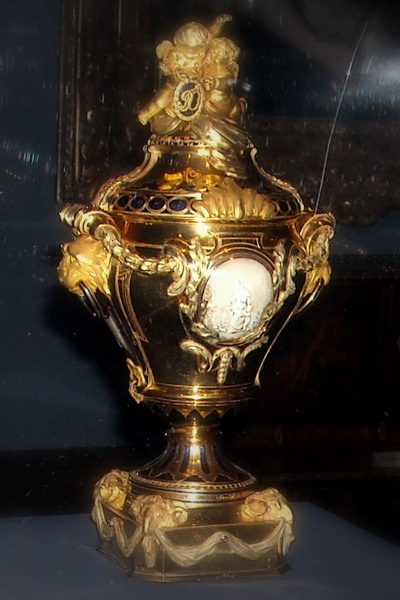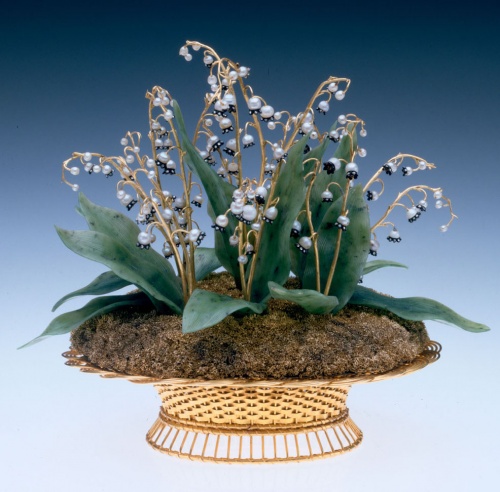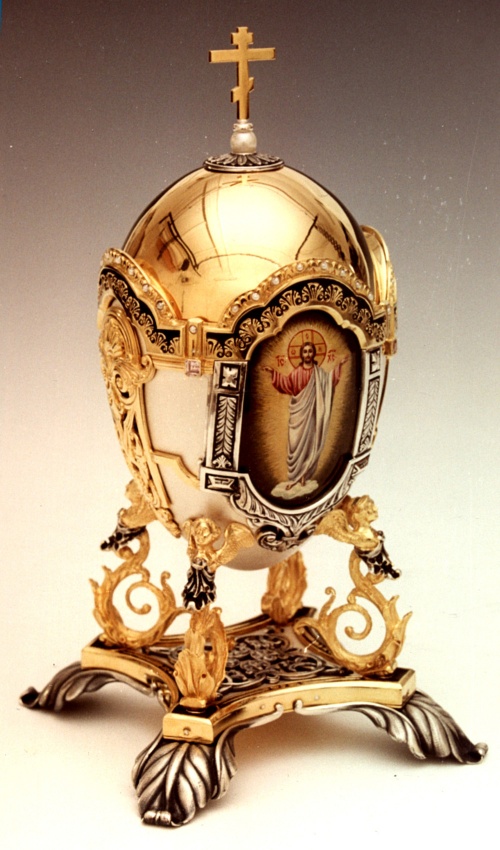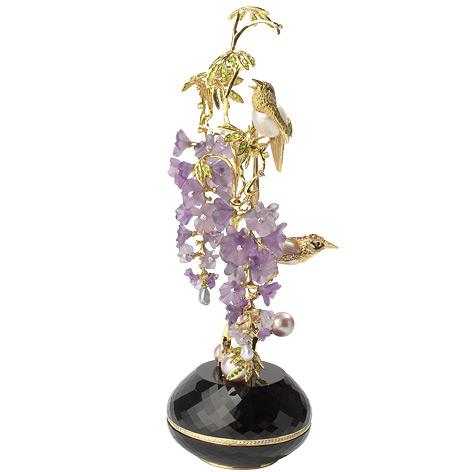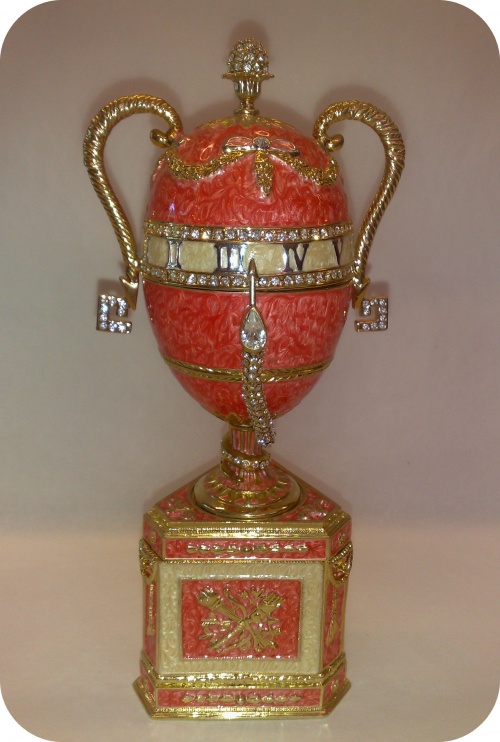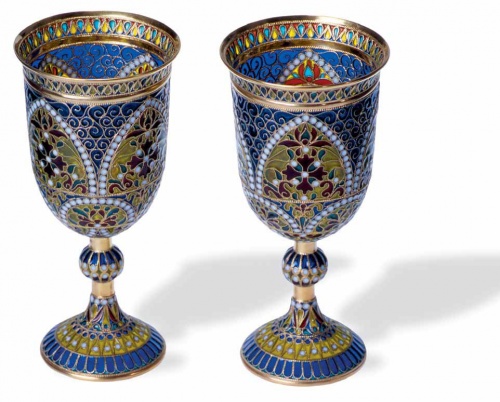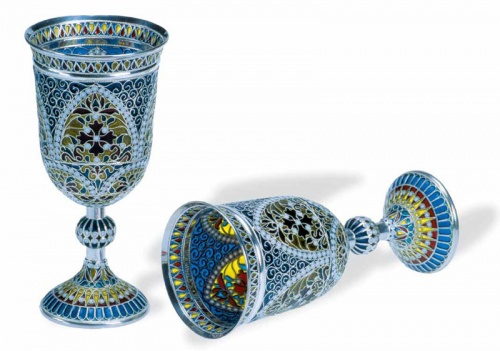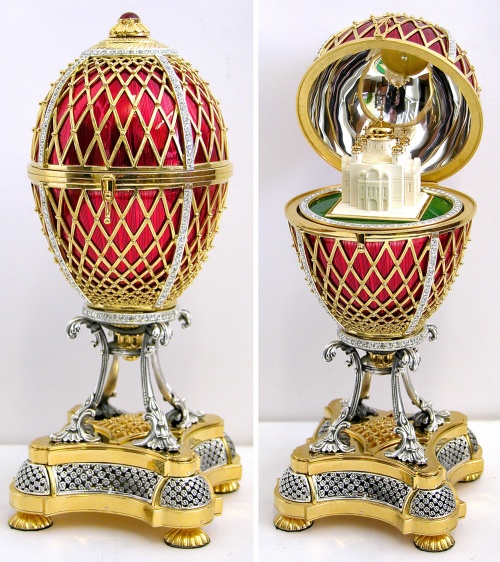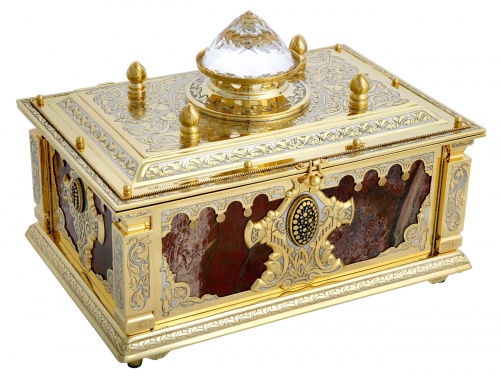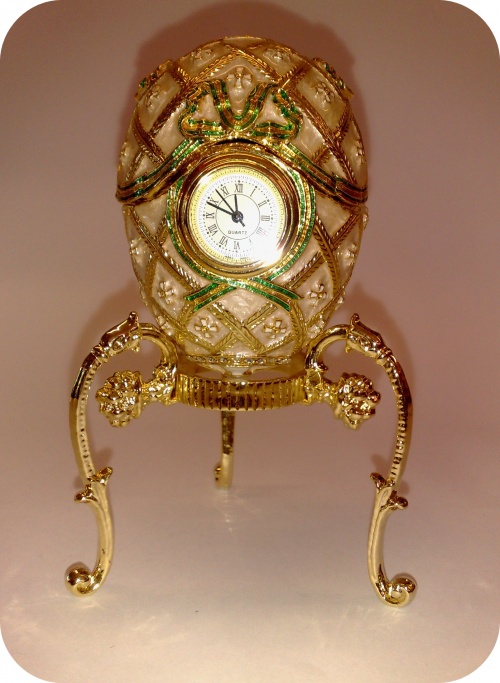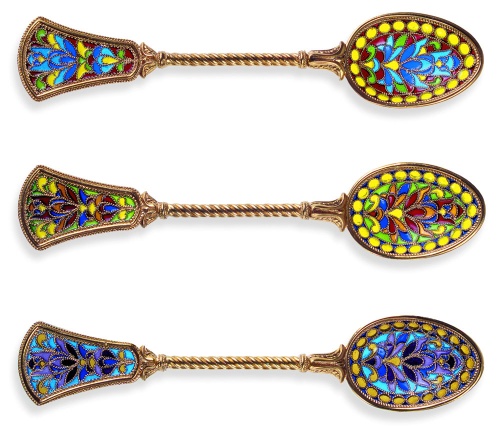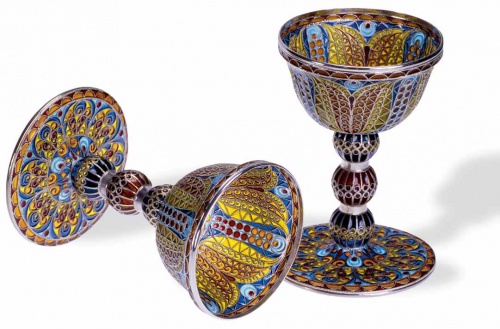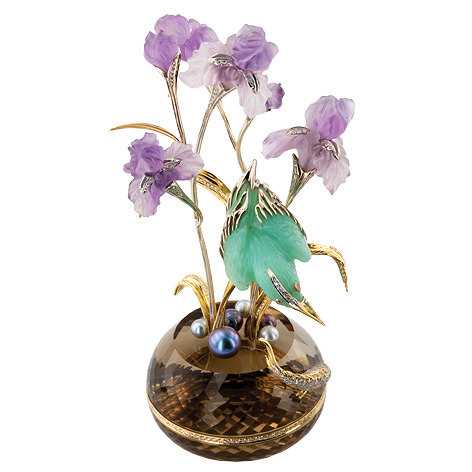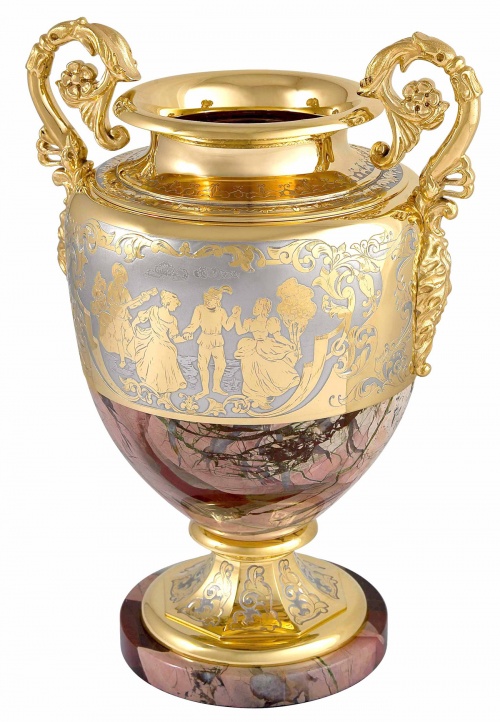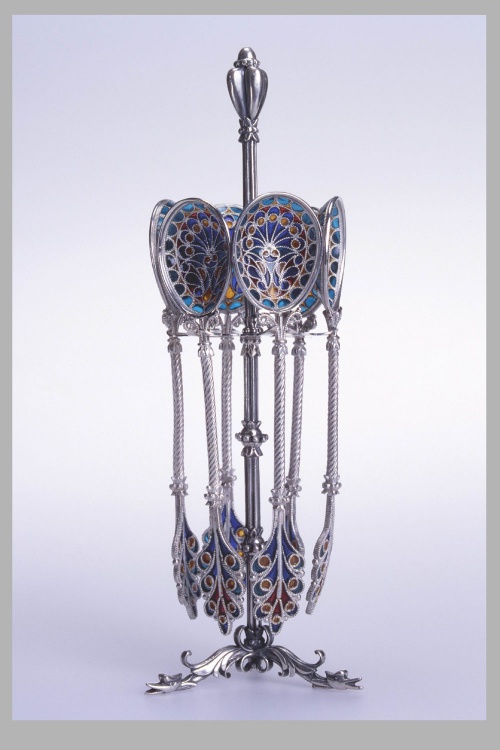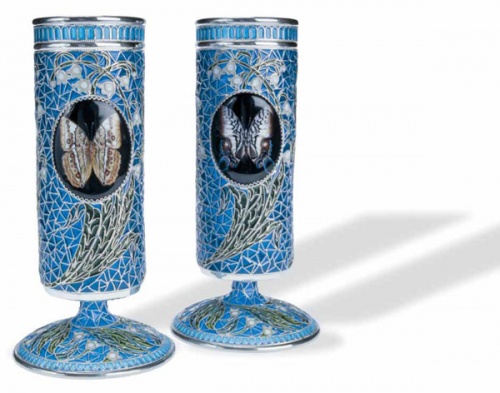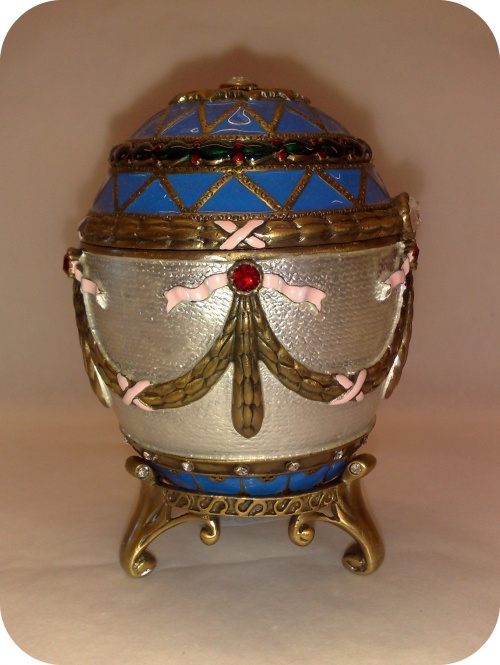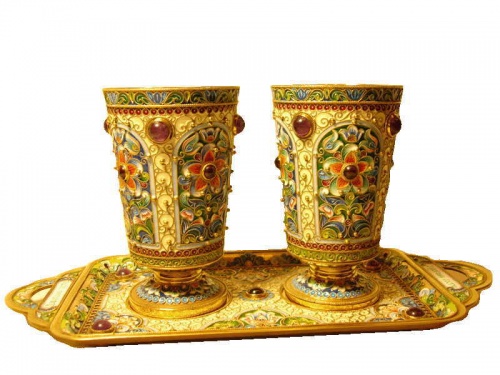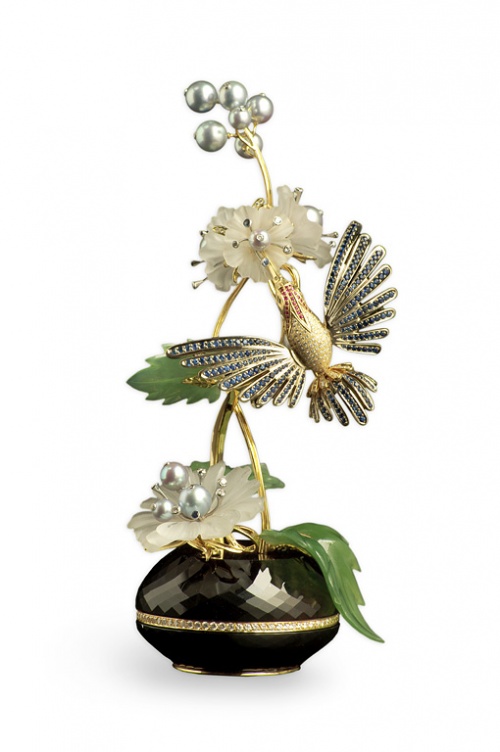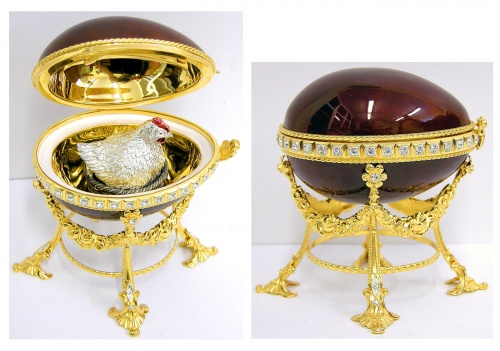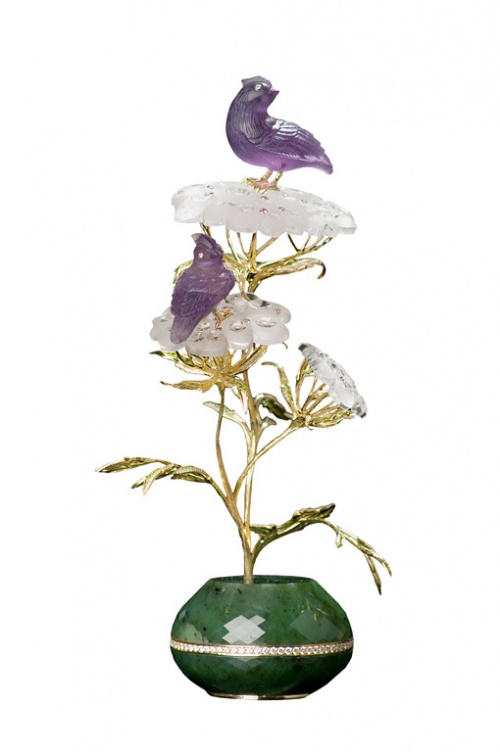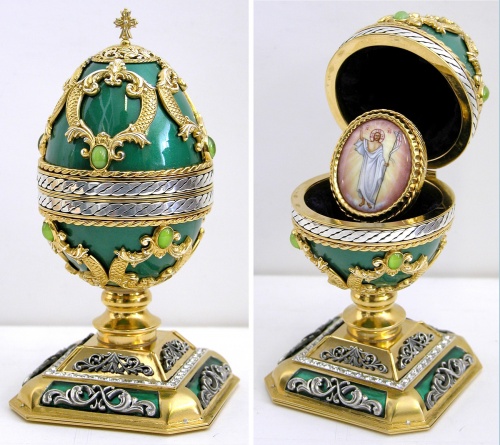Jewelry Art. Faberge (500 photos)
Разрешение картинок от 300x18px до 2931x5191px
The company began in a modest workshop opened in August 1842 in St. Petersburg by Gustav Faberge (1814–1893). In a small workshop they made jewelry that was fashionable at that time: gold bracelets, brooches, medallions, which did not stand out in any way. And only after the sons of Karl and Agathon Gustavovich entered the business, they began to pay special attention to the artistic side of production. The sons received the ability to handle precious metals, their first skills and knowledge from their father, and their artistic vision, ability to compare, analyze, and creative understanding were formed under the influence of Russian and Western culture. Having received an excellent education abroad in Florence, Paris, Dresden, using the latest technical achievements, restoring long-forgotten techniques and inventing new ones, the brothers continued and expanded their father’s work.
Agafon Gustavovich (1862–1895) – impressionable, delicate by nature, was fond of antiques, the art of the East, and sought inspiration in the surrounding nature. From 1882 he worked in the company and was known as a talented designer and “a permanent artist and composer of the St. Petersburg branch of the company.”
Karl Gustavovich (1846–1920) - an ardent admirer of classical styles, a witty conversationalist, a tireless inventor - was talented in everything he did. Despite their different characters and creative preferences, they had much in common in their understanding of art. One of the first works that brought fame to the brothers were copies of Kerch jewelry (made by order of the German Emperor Wilhelm II). To fulfill the order, the Faberge brothers had to restore many forgotten technical techniques and invent new ones. The collections of the gallery of antiquities in the Hermitage became a school for jewelers. Court circles and experts paid attention to the masterfully executed necklace, and numerous orders followed.
In 1870, Carl Faberge became the head of the enterprise. Intelligent, energetic, and possessing brilliant organizational skills, he quickly expanded the enterprise and transformed it into a partnership "C. Faberge" with an authorized capital of 3 million rubles. The company's affairs developed rapidly, fame grew, and the number of orders increased. To meet demand, Faberge opens branches: in Moscow (1887), Odessa (1897), London (1903), Kyiv (1905). In 1906, at the invitation of Prince Chakrabon of Siam, the company opened branches in Bangkok.
As a leader, C. Faberge had a rare ability to find and attract talented people to cooperation. Architects, sculptors, and painters F.O. created drawings and models for the company. Shekhtel, N.A. Klodt, K.A. Klodt, V.Ya. Grachev, G.K. Savitsky, O.O. May, A.N. Benoit, L.N. Benoit, A.S. Golubkina, B.N. Gorsky and many others. Outstanding masters of jewelry and stone cutting worked: M.E. Perkhin, G. Wigström, A. Holmström, E. Collin, V. Zuev, Y. Rappoport, S. Vekeva. We can say that the best artistic forces in Moscow and St. Petersburg collaborated with the company. The spirit of co-creation between artists and highly skilled performers reigned in the workshops.
With the expansion of production and the growth of orders, independent (autonomous) workshops for gold, enamel, and silver products, a stone-cutting workshop and a workshop for the production of signs, tokens, and orders were established. The extensive range of manufactured products included jewelry for the monarchs of the West and East, unique Easter surprises for the imperial family, private orders for guard regiments, institutions of various departments, church utensils, souvenir gifts, photo frames, miniature sculptural figurines of animals and people, toys, watches, bouquets of ornamental stones, cigarette cases, cutlery, etc.
The huge number and variety of products produced indicates the popularity and availability of purchases for the population. During production, of course, the tastes and wealth of various strata of society were taken into account. The company's products could be purchased by both members of the imperial house and people with average incomes. In addition, competition between firms contributed to cheaper products. But regardless of price, items bearing the company’s mark were distinguished by high professional craftsmanship and exceptional purity of execution. Each item had the features of the participation of an artist and craftsman, which gave it expressiveness, uniqueness and made it artistically beautiful.
In 1882, at the All-Russian Industrial and Art Exhibition in Moscow, the company clearly announced itself for the first time and was a major success. The index (catalog) provides brief information and a list of exhibited products: copies from a collection of ancient Greek works found in Kerch; diamond products: rose hips, necklace, bouquet; parure with opals; sevigne of different stones; bracelets, leaf brooch. The technical excellence and beauty of the products attracted attention, received high praise and were awarded a gold medal. During this period, the company's products were sold only in Russia.
In May 1885, Emperor Alexander III awarded Carl Faberge the title of “Supplier to the Supreme Court” with the right to
There is an image of the State Emblem on the sign. (Later, Emperor Nicholas II - the title of “Court Jeweler and Appraiser of the Cabinet of the Imperial Majesty.”) The titles obligated Faberge to carry out orders from the imperial house. For a jeweler bound by court orders, it is quite difficult to maintain creative freedom. Carl Faberge succeeded in this. His tactful but firm defense of his creative ideas before royalty evokes admiration. Especially when it came to Easter surprises. The first original souvenir - a split egg with a chicken, a ruby egg and a crown inside - was made in 1885.
The World Exhibition in Paris in 1900 brought the company worldwide fame. The company's products participated outside the competition, because K. Faberge was a member of the jury. Numerous products from the company were exhibited at the exhibition, among them were miniature copies of royal regalia - large and small crowns, an orb, a scepter - made of precious metals and stones and mounted on a stand made of pink eagle. (The regalia were purchased from the exhibition by Emperor Nicholas II, and are currently stored in the Hermitage). The “Trans-Siberian Railway” egg by master M. Perkhin is now in the Moscow Kremlin Museum. The highly artistic works of the company's craftsmen made a huge impression on visitors and the jury. Experts appreciated the jewelry work. C. Faberge received the Grand Prix and the French Legion of Honor. The Parisian Guild of Goldsmiths awarded him the title of meter. The eldest son Evgeniy received a palm branch - the badge of an officer of the Academy of Fine Arts. Many masters were awarded gold and silver medals. After success at the exhibition, the company becomes a supplier of jewelry for all the royal houses of Europe and primarily England, Sweden, Norway, Germany, Denmark, and France.
By order of the Russian court, the company's craftsmen made items for diplomatic gifts and various offerings. At different times, masterpieces of jewelry and stone-cutting came from the hands of master artists: a decorative vase for Bismarck, a bratina for the Abyssinian Negus Menelik, a jade wreath for the tomb of the Swedish king Oscar II, a jade figure of Buddha and a lamp for the court temple in Siam, etc. One of Evidence of the perfection of the manufactured products is provided by the repeated offers of Western antique dealers to carry out a number of works without imposing stamps with the name of the company. These proposals were immediately rejected.
Before the First World War, about 600 people worked in the workshops. The war reduced production. The company adapted its workshops to the needs of wartime. In the first year of the war, the workshops made bowls, plates, mugs, and tobacco bowls. After receiving the military order, they began to produce impact and remote tubes, grenades, and instrument parts. The military department has repeatedly cited the company's products as an example for the accuracy and thoroughness of execution.
The company's branches closed in 1918, the store in Moscow was open until February 1919. Carl Faberge, under the guise of a diplomatic courier, left Petrograd for Switzerland with his family in 1918. Abroad, deprived of the opportunity to do what he loved, he suffered painfully from inactivity. During this period, those around him often heard from him: “... such a life is no longer a life when I cannot work and be useful. There is no point in living like this.” On September 20, 1920, the great master passed away. In St. Petersburg, two sons worked under Karl Gustavovich - Evgeniy and Agathon, in Moscow - the third son Alexander, and in London - the younger Nikolai. In exile, in Paris, Evgeniy and Alexander opened a small enterprise, Faberge & Co., which sold the company's old products and also manufactured and designed new ones. It closed in 1960, when the last of the family members who worked there, Eugene Faberge (1874–1960), died. The production of products in Geneva was carried out by Fyodor Faberge (1904–1971) and his daughter Tatiana. The heirs of K. Faberge failed to revive the former glory of the company.
Unfortunately, a huge number of Faberge products during the revolution, and especially in the 1920s and 1930s, were taken out of the country and distributed throughout the world. They are in the English Royal Collection - more than 450 items, in private collections: Melcom Forbes - about 360 items, Armand Hammer - 13 Easter eggs, Emmanuel Snowman - 9 Easter eggs, as well as in many museums in the USA and Europe. A small part of the products is in museums and private collections in Russia.
It should be noted that the enormous popularity of the company gave rise to many fakes that appeared already in the 1920s. The fakes, which were made both in Russia and abroad, often bore genuine Faberge marks. The book “Faberge and St. Petersburg Jewelers” reports: “... as it became known from ... the book of the last secretary Armand Hammer, in the early 1930s Anastas Mikoyan gave Hammer the original hallmarks of the Faberge company. Hammer organized the production of counterfeits, branding them with genuine marks. Items were sold in one stream with the original ones.” Later for the real "pre-revolutionary Carl Fabe"
rzhe" were issued products made by brothers Eugene and Alexander Faberge in Paris. In the 1950s, Fyodor Faberge discovered a workshop that made “Faberge cases” for an anonymous customer.
Currently, there are world trade centers for Faberge products. These are Paris, New York, London, Switzerland. Leading auction firms Sotheby's and Christie's have regularly held auctions of Faberge items since the 1930s.
Jewelry art. Faberge
Faberge's Last Imperial Easter Egg
In the collection of the Mineralogical Museum. A.E. Fersman RAS there is a unique exhibit - the unfinished last imperial egg, created at the Faberge company for Easter 1917.
The chief artist of the Faberge company, F.P. Birbaum, wrote in 1922: “... an egg of blue glass, on which the constellation of the day on which the heir was born was inlaid. The egg was supported by silver cupids and clouds of frosted rock crystal. If I'm not mistaken, there was a clock inside with a rotating dial. The production of this egg was interrupted by the war. Cupids, clouds, the egg itself with inlays were ready, and the pedestal was not finished...”
The imperial egg ended up in the Mineralogical Museum in 1925, when A.K. Fabergé, before fleeing abroad, gave A.E. Fersman a number of products from his company, including a disassembled composition of two halves of a dark blue glass egg and a stand in the form of a translucent clouds with a matte surface, carved from rock crystal. The lower half of the egg is noticeably elongated, while the upper half is almost an ideal hemisphere in shape. Recently, this Easter egg has been described under the name “Tsarevich Alexei”.
Symbolic images of the constellations are engraved on the cobalt glass of the upper half of the egg, showing their main stars. Along with them, other celestial bodies are depicted here. “Stars” are depressions (mostly filled with mastic) with five to eight (usually six) extending “rays”. The diameter of the depressions is 1–2.5 mm, some of them contain small diamonds (“sparks”), which were supposed to represent stars. There is one larger depression, around which the “rays” are not cut, its diameter is about 4 mm. When compared with star atlases, it becomes clear that the glass hemisphere, despite its small size (radius about 37 mm), is a completely accurate model of part of the celestial sphere.
A comparison of symbolic images of constellations with their images in various star atlases showed that the graphic basis of the images on the glass hemisphere is closest to the images of the constellations placed in the first Russian atlas of the starry sky, published by an honorary member of the Imperial Academy of Sciences Cornelius Reissig (1781–1860). This atlas, entitled “Constellations presented on XXX tables, with a description of them and a guide to conveniently finding them in the sky...”, was published in St. Petersburg in 1829. “When drawing up these drawings, I took Bode’s celestial Atlas as the basis, preserving its entire order, excluding some small changes...” writes Reissig in the Atlas Pre-Notice.
In turn, the images of the constellations in Bode’s “Uranography” (published in 1801) largely repeat the images in the earlier atlases of John Flamsteed (1725) and Jan Hevelius (1690).
However, the original picture for the engravings on the Easter egg was not the Reissig atlas itself. The set of constellations on the glass hemisphere, as it turned out, does not correspond to the beginning of the 20th century, when the egg was created, and not to the 20s of the 19th century, when the atlas was published.
In the long history of astronomy, the celestial boundaries between constellations, as well as between countries, have changed, some constellations have appeared and disappeared. The reflection of these changes in atlases of different times, the history of now “outdated” constellations, can connect artistic representations of the firmament with the time in which they were created.
The master of the Faberge company with great care, down to the smallest detail, reproduced the symbolic images of the constellations and their relative positions. The presence in that part of the “firmament”, which is depicted on the Easter egg, of such constellations as Reindeer (Rangifer Tarandus), Cerberus and Apple Tree Branch (Cerberus Ramus), in the absence of the constellations Custos Messium, Wall Quadrant (Quadrans Muralis) , “Herschel’s Large Telescope” (Telescopium Herschelii Major), limits the possible period of creation of the graphic basis for images of constellations to the 40–80s of the 18th century.
The main difference between the picture of the celestial vault on a glass hemisphere and the image of the celestial sphere in star atlases (at least since the 18th century) is the mirror image of the constellations in relation to the picture observed in reality.
Consequently, it can be assumed that the graphic basis of the images on the upper hemisphere of the “Tsarevich Alexei” egg was a celestial globe with constellations, the list and appearance of which corresponded to the situation that developed in uranography (visual astronomy) between the 40s and 70s of the 18th century. This globe was not necessarily made in the 18th century.
century, it may have been a later copy.
The location and relative brightness of the “stars” on the hemisphere are quite arbitrary. The master tried to display some of the most significant (Polar) and brightest stars located in the depicted area of the celestial sphere (Arcturus, Vega, Deneb, Capella, Procyon, Antares, Castor, Pollux, Aldebaran, Spica), with slightly larger indentations - about 1.5 mm (that is, larger diamonds were assumed here). The remaining stars correspond to almost identical depressions with a diameter of about 1 mm. There are depressions of the same size within the constellations, where there are practically no stars visible to the eye. Small constellations are symbolically marked with two or three stars.
However, with such a small size of the “vault of heaven,” this convention is quite understandable.
It is clear that the main task here was to create a visual effect of “the sky in diamonds.”
However, with regard to the location of celestial bodies here, which in the minds of astrologers are responsible for human destinies, all convention recedes.
First of all, it was necessary to understand why the Easter egg depicts precisely the selected part of the celestial sphere. When copying, it would be natural to directly transfer the images from the hemisphere of the star globe to the hemisphere of the Easter egg. But the location of the constellations on the glass hemisphere does not at all coincide with the stellar hemisphere, distinguished by the equatorial system of celestial coordinates typical of globes. The central point of the glass hemisphere does not correspond to the North Star - it is located in the “bucket” of the Big Dipper.
Using Birbaum’s hint—the egg “is inlaid with the constellation of the day on which the heir was born”—we will enter information about when and where the heir to the Russian throne was born into a computer program that simulates the appearance of the starry sky. Time - 11 hours 15 minutes (known from the diaries of Nicholas II, Greenwich time), August 12 (Gregorian calendar), 1904, place - Peterhof (coordinates are almost identical to the coordinates of St. Petersburg).
What do we see? The glass hemisphere depicts exactly those constellations that were above the horizon in Peterhof at the time of the birth of Tsarevich Alexei. The picture, of course, is theoretical - Alexey was born around noon, when we are not talking about observing stars.
Modeling also helps to understand larger depressions on the hemisphere. The largest of them, undoubtedly, corresponds to the location of the Sun on August 12, when it is in the constellation Leo for the first day.
Within the boundaries of the zodiacal constellations there are four more large depressions surrounded by “rays”, with a diameter of about 2.5 mm. When looking at the star map calculated for the moment of the birth of the Tsarevich, it is clear that they correspond with great accuracy to the location of the planets at that time. To the left of the Sun, Venus practically coincides in location with Regulus (a Leo).
About 10 degrees to the left of Venus, also in the constellation Leo, is Mercury. To the right of the Sun, on the border of Cancer and Gemini, Mars is located. A point in the constellation Gemini, noticeably larger in size than the depressions corresponding to the brightest stars of the constellation Castor and Pollux, can only correspond to the planet Neptune.
There is no doubt that the master would have supplemented this “parade of planets” with the planet Pluto, which at the estimated time was above the horizon in the constellation Orion, but it would only be discovered 13 years after the attempt to create an astronomical Easter egg.
The planets Jupiter and Saturn, which are important for astrological forecasts, did not fall into the hemisphere, since at the calculated moment they were below the horizon, respectively - in Pisces and Capricorn.
The “parade of planets” also includes the Moon, whose age after the new moon by 13.15 St. Petersburg time does not exceed one day. It was not immediately possible to find the Moon on the hemisphere. This is a crescent a little more than 3 mm, as expected, with its convexity directed towards the Sun.
It can be assumed that the symbolic images of the planets on the Easter egg, in contrast to the diamond stars, were supposed to represent other gems, individual for each celestial body, selected in accordance with the astrological concept of the correspondence of stones and planets. The lunar crescent, most likely, should have been emphasized by a metal insert (gold or, more likely, silver - the metal of the Moon in the alchemical tradition).
By the beginning of the 20th century, a wave of interest in the occult had reached Russia, coming from Europe and the USA; astrology was becoming increasingly popular, and many books related to it were being published. The main publication promoting and popularizing astrology was the magazine “Isis”, which was published in 1909–1916 in St. Petersburg.
Occultism and mysticism were also characteristic of the royal family. In the first years of the new century, both the famous French spiritualist Papus and another French palmist-clairvoyant Philippe were close to Nicholas II and Alexandra Feodorovna (Alexandra Fedorovna, in a letter dated December 14, 1916, remembers him as “our friend Monsieur Philippe”).
Surely the royal family did not escape the hobby of asters
ology.
The most accurate reproduction of the celestial sphere on the Easter egg suggests that it was supposed to become the “natal chart” of the crown prince. In addition to the work and art of stone cutters and jewelers, it is important to note the great contribution of astronomers in calculating the location of celestial bodies at the time of Alexei’s birth. In Carl Fabergé's sketch, the 1917 egg has a spherical shape, which indicates its original purpose to display the entire celestial sphere. Later, this idea was harmoniously combined with the Easter tradition, and the “vault of heaven” became the top part of the Easter egg.
It is difficult to say what exactly the astrologers of that time foreshadowed on Easter 1917 for the heir to the throne, who was shot with his entire family just 15 months later. But still, the magical vault of the “heavenly” egg absorbed the art of the Faberge jewelers, the hopes and tragedy of the royal family, the history of the greatness and collapse of the Russian Empire.
